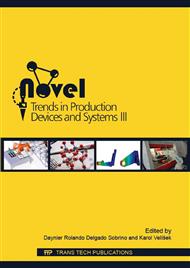[1]
I. A. Choudhury, O. H. Lai, L. T. Wong, Pam-Stamp in the simulation of stamping process of an automotive component, Simulation Modelling Practice and Theory, 14 (2006) 71-81.
DOI: 10.1016/j.simpat.2005.04.002
Google Scholar
[2]
L. Wang, T. C. Lee, The effect of yield criteria on the forming limit curve prediction and the deep drawing process simulation, Int. J. of Machine Tools & Manuf., 46 (2006) 988-995.
DOI: 10.1016/j.ijmachtools.2005.07.050
Google Scholar
[3]
E. Spišák, Mathematical modelling and simulation of technology processes – deep drawing, first ed., TYPO Press, Košice, (2000).
Google Scholar
[4]
Z. Sun, Y. Zhang, Y. Li, R. Zhang, Y. Zhong, Influence of the blank contour to drawing deformation of the oil tank with 304 strainless steel, Adv. Mat. Research, 421 (2012) 640-643.
DOI: 10.4028/www.scientific.net/amr.421.640
Google Scholar
[5]
E. Kormaníková, K. Kotrasová, Finite element analysis of damage modeling of fiber reinforced laminate plate, Applied Mechanics and Materials, 617 (2014) 247-250.
DOI: 10.4028/www.scientific.net/amm.617.247
Google Scholar
[6]
T. Himmer, A. Techel, S. Nowotny, E. Beyer, Recent developments in metal laminated tooling by multiple laser processing, Rapid Prototyp. J., 1 (2003) 24-29.
DOI: 10.1108/13552540310455629
Google Scholar
[7]
T. Himmer, T. Nakagawa, N. Mohri, Rapid Die Manufacturing System, Proc. of the 7th European Conf. on Rapid Prototyp. and Manuf., (1998).
Google Scholar
[8]
T. Nakagawa, Recent Developments in Auto Body Panel Forming Technology, Annals of the CIRP vol. 42/ 2/ (1993).
DOI: 10.1016/s0007-8506(07)62534-7
Google Scholar
[9]
Pam Stamp 2G User's Guide, ESI Group, (2015).
Google Scholar
[10]
L. Pollák, Normal anisotropy as a deep-drawability criterion of steel sheets. Int. Sheet Metal Rev., 1 (1999) 84.
Google Scholar
[11]
S.Y. Betsofen, V.I. Slavov, V.N. Matsnev, O.S. Kostykova, Texture and anisotropy of a plastic flow in low-carbon deep-drawing steels, Russian Metallurgy, 5 (2004) 484-488.
Google Scholar
[12]
L. Pollák, Anisotropy of sheetmetals, first ed., Alfa, Bratislava, (1978).
Google Scholar
[13]
A. Hrivňák, E. Evin, Formability of steel sheets, first ed., ELFA Košice, (2004).
Google Scholar
[14]
Z. Wang, T. Nakamura, M. Yamashita, K. Nishimoto, Friction behavior of lubricant pre-coated steel sheet in deep drawing process, Materials Forum, 29 (2005) 279-284.
Google Scholar


